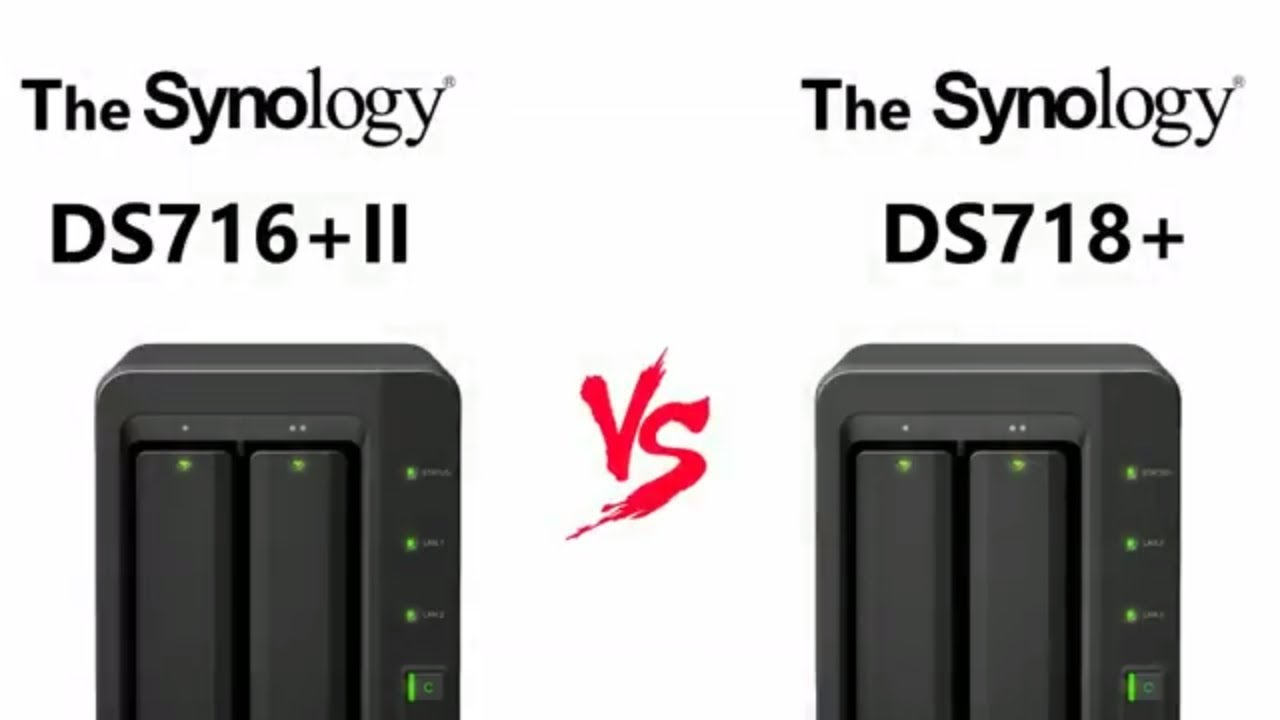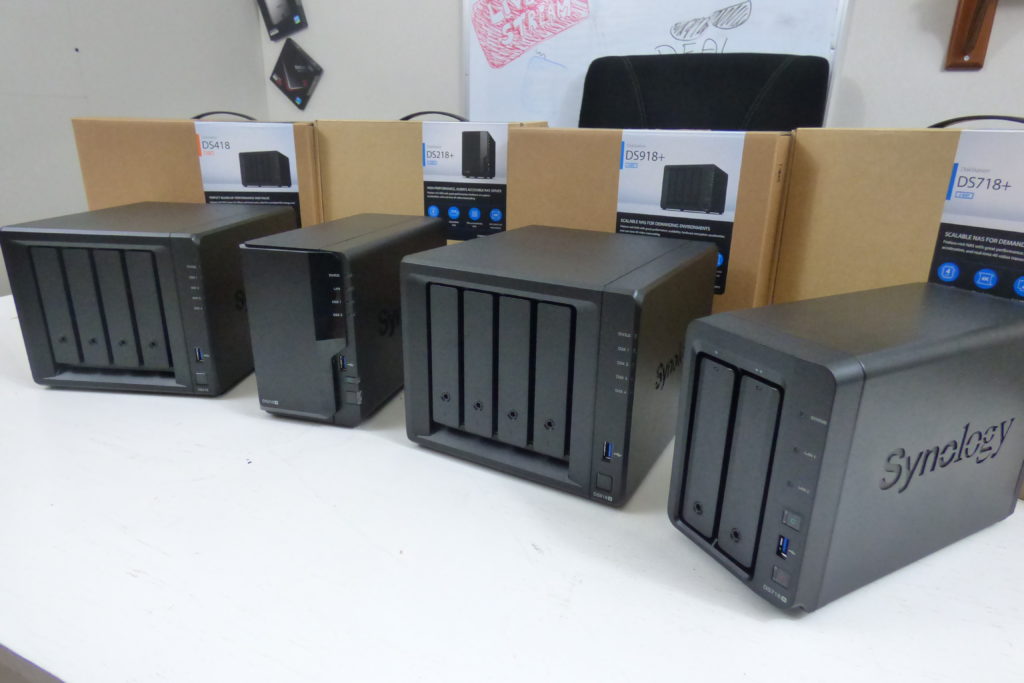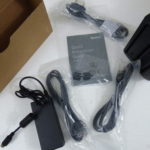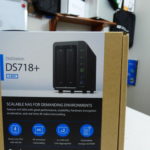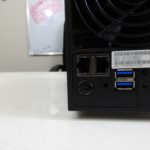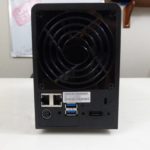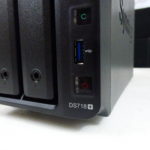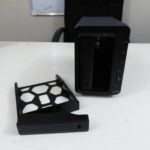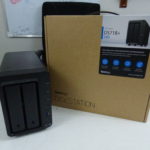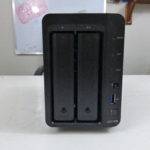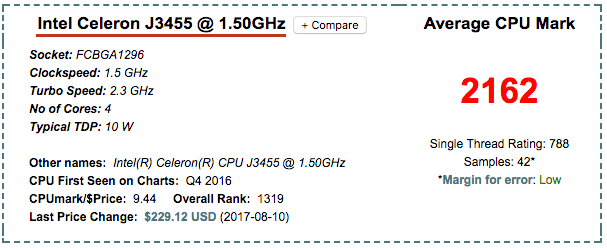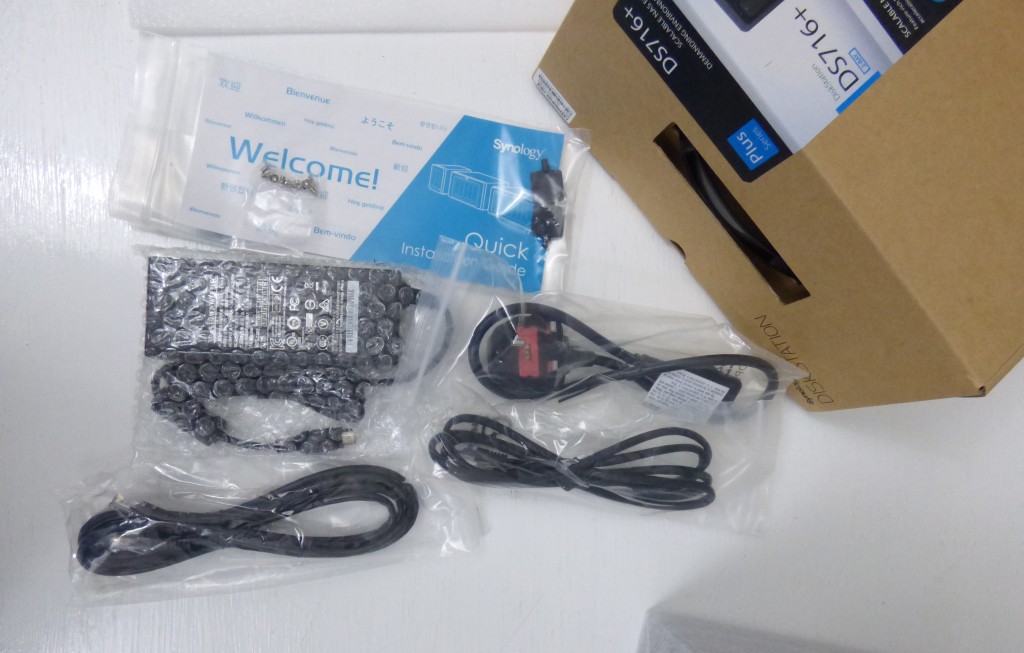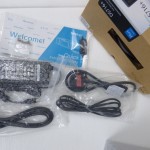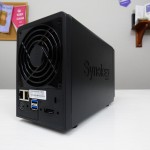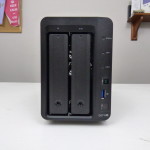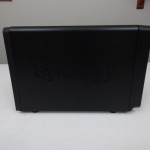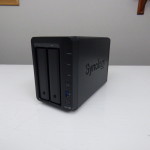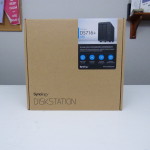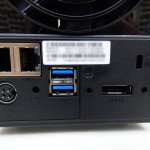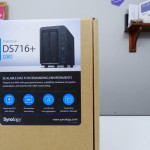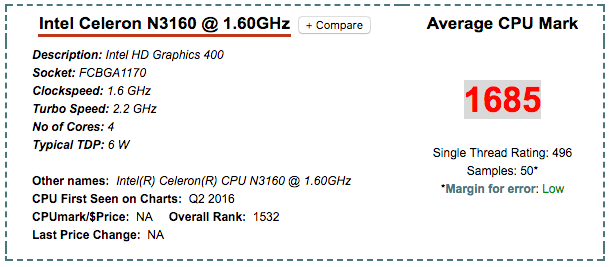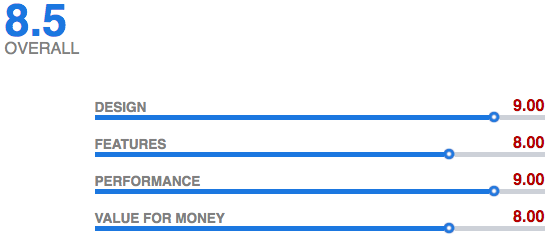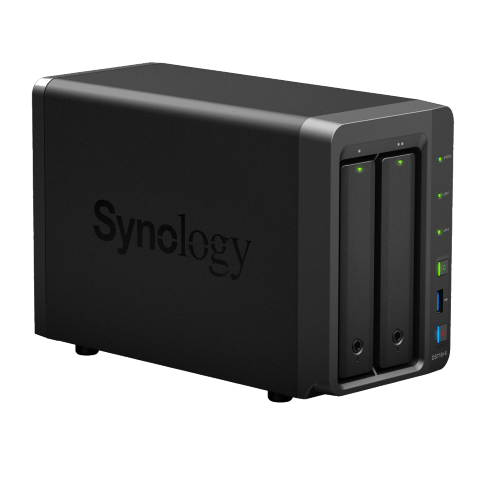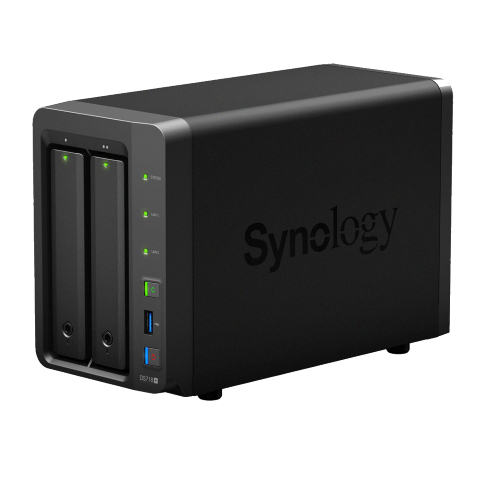Which is the best 2-Bay Synology NAS? The DS718+ or the DS716+II?
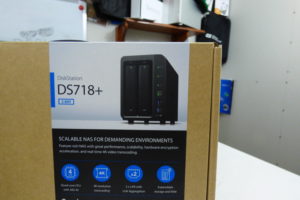 Synology have been pretty much leading the pack when it comes to home NAS for a number of years. Though in recent years we have seen a lot of back and forth between them and QNAP NAS, it is safe to say that their reputation for a solid and user-friendly NAS server has been pretty in arguable. Many first time NAS buyers gravitate towards Synology for that very reason as it can be an intimidating purchase and the more user-friendly and streamlined the device, the better. That said, when you buy a NAS – you want it to last for as long as possible. I am not just talking about build quality, but sheer power and hardware to stave off obsolescence for as long as possible. It is for reasons such as these that the popularity of the flagship DS716+ 2-Bay from way back in the closing stages of 2015 was no surprise. It has fantastic hardware specs, is compact, low-cost and featured numerous ways in which to expand and improve as the years went on.
Synology have been pretty much leading the pack when it comes to home NAS for a number of years. Though in recent years we have seen a lot of back and forth between them and QNAP NAS, it is safe to say that their reputation for a solid and user-friendly NAS server has been pretty in arguable. Many first time NAS buyers gravitate towards Synology for that very reason as it can be an intimidating purchase and the more user-friendly and streamlined the device, the better. That said, when you buy a NAS – you want it to last for as long as possible. I am not just talking about build quality, but sheer power and hardware to stave off obsolescence for as long as possible. It is for reasons such as these that the popularity of the flagship DS716+ 2-Bay from way back in the closing stages of 2015 was no surprise. It has fantastic hardware specs, is compact, low-cost and featured numerous ways in which to expand and improve as the years went on.
Now almost two years later we have the release of the follow-up device, the Synology DS718+ NAS for 2017 and 2018. Building on those factors that made its predecessor great, it brings a few more tricks up it’s sleeve and it is really making many a NAS buyer scratch their head and wonder whether to buy the older model and save a few quid or go for the brand new synology NAS? Even buyers who bought the DS716+ at launch wonder whether to upgrade. So, which of the DS716+ and DS718+ deserve your data?
What can you do with a Synology NAS Diskstation?
As already covered here at NASCompares, regardless of which Synology NAS you buy, be rest assured that you are getting one of the most powerful and able network attached storage servers available in 2017 and 2018. Either one will provide the following:
- Includes the Synology DSM 6.1 (6.2 in beta) Operating system Free and with regular updates
- BTRFS and EXT 4 File systems to choose from so you have adapt and support your storage accordingly
- Support for RAID 0, RAID 1 and the always popular and adaptable SHR (Synology Hybrid RAID).
- Alongside the two HDD/SSD bays, you can attach the DX513 or DX517 expansion device to add an additional 5 HDD/SSD Bays as needed. These drives can be added to your Synology NAS in a RAID 5, 6, 50, 60 or expand the SHR across all seven drives
- Host a virtualization Platform, meaning that you can set up and run multiple Virtual Machines, supporting the likes of Android, Windows and Ubuntu
- Personal and business software applications included free like Synology Office (docs, spreadsheets, pdfs, etc), Synology LiveChat, Synology Mail, Photo Station, Video Station, Music Station, Download Station and more
- Both units cab be used as a fantastic Plex Media Server for transcoding on the fly and more
- 4K Native transcoding, though the DS716+II can only transcode a single media stream, the DS718+ can support 2x media streams at once
- Serve as a cross-platform service – bridging connections and transfers of files between Mac and Windows systems over the network. NO longer is communication between varying hardware platforms an issue
- Heavily support backups, archiving, remote replication and comprehensive snapshot technology meaning you will have an equal amount of backup options whichever you go for. As well as migration, connection and interaction with existing cloud services like dropbox, Google Drive, ElephantDrive and Synology C2
- Create a comprehensive Surveillance solutions, supporting multiple IP cameras and even arriving with some licences included. Suitable for both the home and small/medium business surveillance needs
So, regardless of whether you buy the Synology DS718+ or the DS716+II, you have a very solid NAS at your disposal.
Synology DS718+ Diskstation NAS, Why should you buy it?
The New DS718+ NAS from Synology was released in Late September 2017 and arrived alongside a number of high-profile Diskstation NAS. Check out our unboxing below:
What are the Pros and Cons of the Synology DS718+?
DESIGN – Keeping the older chassis from the previous unit DS716+II is a smart move. The result is that costs are being kept VERY close to that of the previous unit. It is both compact, cool and quiet (though the noise of the drives should always be kept into consideration)
FEATURES – BY FAR the most powerful and able 2-Bay from Synology and at this price level, it is VERY hard to beat. It can do EVERYTHING – Trancode 4K, Run as a Plex Media Server with transcoding, host a few virtual machines, store images in apple time machine – every thing most people need a NAS for, this unit can do it
PERFORMANCE – Alongside the ability to perform all of the tasks you need from a NAS server in 2017 and 2018, you will have the high-speed of read and write from the dual LAN ports. As well as supporting both the BTRFS files system and the SHR configuration – both of which vastly improve your performance and integrity of your data
VALUE – Easily one of the best NAS servers of 2017. It has the power, the price and the compact size to fulfil your NAS needs and provide an ample storage solution.
DESIGN – Still not sure why they didn’t update the chassis, as they have done with the DS218+
FEATURES – As it is just a 2-Bay, you will need to buy the DX517 to expand to higher than 2 HDD/SSD. If you need more than 2 bays for immediate storage, go for the DS918+
PERFORMANCE – The RAM can only be expanded to 6GB – As opposed to 8GB as you might expect. The 4GB Memory upgrade is available from Synology, but still a shame you cannot officially exceed the 6GB Memory
VALUE – The only real negative for me was that the price is only £60-70 lower than the DS918+ 4-Bay, which features NVMe SSD storage on top and 4GB of goes upto 8GB.
Synology DS716+II Diskstation NAS, Why should you buy it?
As mentioned earlier, the Synology DS716+ was released back in late 2015, however it was hit with the same CPU shortage that affected the DS216+ and in May of 2016 a revised version of the DS716+ was released with a new CPU and a slightly higher price tag. The DS716+II would go on to be more popular than the previous revision and is still held up as one the best 2-Bay NAS devices of recent years. Below is what we thought when we unboxed the DS716+ and when we covered the release of the DS716+II:
What are the Pros and Cons of the Synology DS716+II?
DESIGN – Clean design, Metal and in keeping with the rest of the Synology 2 Bay Series
FEATURES – Good mix of enterprise and Home user functionality
PERFORMANCE – Easily the most powerful and capable Synology 2 Bay device to date
VALUE – Good price for those looking for a Solid Start to Network Attached Storage with an option to expand later
DESIGN – Although the majority of the chassis is made of metal, the trays are plastic and they feel a little flimsy
FEATURES – Lack of HDMI port will disappoint some users
PERFORMANCE – Performs very well, however should be highlighted than the inability to upgrade the RAM seems a little silly for a flagship Synology NAS
VALUE – More expensive than most 2 bay units and may be a little high for those with basic requirements
Should you buy the Synology DS718+ or the DS716+II – Conclusion
In almost every single regard, the Synology DS718+ is a better NAS than the DS716+II, so if you are about to choose between which unit to buy – go for the Synology DS718+. However, if you already own the Synology DS716+II, you do not really need to upgrade to this new unit. It may have a new and more efficient CPU, as well as the ability to upgrade RAM officially, but other than that it is a very similar NAS indeed and cannot justify the £380 upgrade cost. If you already own the DS716+, maybe wait till the release of a DS719+ or more.
Still not convinced? Below are the specifications and how they compare:
|
£330+ ex.VAT |
£380 ex.VAT |
| CPU | ||
| CPU Model | Intel Celeron N3160 | Intel Celeron J3455 |
| CPU Benchmark | 1685 | 2162 |
| CPU Architecture | 64-bit | 64-bit |
| CPU Frequency | Quad Core 1.6 burst up to 2.24 GHz | Quad Core 1.5 burst up to 2.3 GHz |
| Hardware Encryption Engine | YES | YES |
| Hardware Encryption Engine (AES-NI) | YES | YES |
| Hardware Transcoding Engine | H.264 (AVC), H.265 (HEVC), MPEG-2 and VC-1; maximum resolution: 4K (4096 x 2160); maximum frame rate per second (FPS): 30 | H.264 (AVC), H.265 (HEVC), MPEG-2 and VC-1; maximum resolution: 4K (4096 x 2160); maximum frame rate per second (FPS): 30 |
| Memory | ||
| System Memory | 2 GB DDR3 | 2 GB DDR3L |
| Memory Module Pre-installed | 2GB (1 x 2GB) | 2GB (1 x 2GB) |
| Total Memory Slots | No | 2 |
| Memory Expandable up to | No | 6 GB (2 GB + 4 GB) |
| Storage | ||
| Drive Bays | 2 | 2 |
| Maximum Drive Bays with Expansion Unit | 7 | 7 |
| Compatible Drive Type* (See all supported drives) |
|
|
| Maximum Internal Raw Capacity | 20 TB (10 TB drive x 2) (Capacity may vary by RAID types) | 20 TB (10 TB drive x 2) (Capacity may vary by RAID types) |
| Maximum Raw Capacity with Expansion Units | 70 TB (10 TB drive x 7) (Capacity may vary by RAID types) | 70 TB (10 TB drive x 7) (Capacity may vary by RAID types) |
| Maximum Single Volume Size |
|
|
| Hot Swappable Drive | YES | YES |
| External Ports | ||
| RJ-45 1GbE LAN Port | 2 (with Link Aggregation / Failover support) | 2 (with Link Aggregation / Failover support) |
| USB 3.0 Port | 3 | 3 |
| eSATA Port | 1 | 1 |
| Expansion Port | YES | YES |
| USBCopy | YES | YES |
| File System | ||
| Internal Drives |
|
|
| External Drives |
|
|
| Notes |
|
|
| Appearance | ||
| Size (Height x Width x Depth) | 157 mm x 103.5 mm x 232 mm | 157 mm x 103.5 mm x 232 mm |
| Weight | 1.75 kg | 1.74 kg |
| Others | ||
| System Fan | 92 mm x 92 mm x 1 pcs | 92 mm x 92 mm x 1 pcs |
| Fan Speed Mode |
|
|
| Noise Level* | 18 dB(A) | 18.4 dB(A) |
| Scheduled Power On/Off | YES | YES |
| Wake on LAN/WAN | YES | YES |
| Power Consumption* | 19.14 W (Access) 9.50 W (HDD Hibernation) |
20.1 W (Access) 9.1 W (HDD Hibernation) |
| British Thermal Unit | 65.35 BTU/hr (Access) 32.44 BTU/hr (HDD Hibernation) |
68.58 BTU/hr (Access) 31.05 BTU/hr (HDD Hibernation) |
| Warranty | 3 Years | 3 Years |
| Storage Management | ||
| Supported RAID Type |
|
|
| SSD Support | ||
| SSD Read/Write Cache | YES | YES |
| Surveillance Station | ||
| Maximum IP cam (Licenses required) | 40 (including 2 Free License) (See All Supported IP Cameras) | 40 (including 2 Free License) (See All Supported IP Cameras) |
| Total FPS (H.264)* | 1200 FPS @ 720p (1280×720) 800 FPS @ 1080p (1920×1080) 300 FPS @ 3M (2048×1536) 250 FPS @ 5M (2591×1944) |
1200 FPS @ 720p (1280×720) 800 FPS @ 1080p (1920×1080) 350 FPS @ 3M (2048×1536) 280 FPS @ 5M (2591×1944) 170 FPS @ 4K (3840×2160) |
| Total FPS (MJPEG)* | 450 FPS @ 720p (1280×720) 150 FPS @ 1080p (1920×1080) 100 FPS @ 3M (2048×1536) 72 FPS @ 5M (2591×1944) |
450 FPS @ 720p (1280×720) 250 FPS @ 1080p (1920×1080) 200 FPS @ 3M (2048×1536) 100 FPS @ 5M (2591×1944) |
| Total FPS (H.265)* | 1200 FPS @ 720p (1280×720) 1200 FPS @ 1080p (1920×1080) 600 FPS @ 3M (2048×1536) 480 FPS @ 5M (2591×1944) 200 FPS @ 4K (3840×2160) |
|
| Video Station | ||
| Maximum Transcoding Channel Number |
|
|
Need Help?
Where possible (and where appropriate) please provide as much information about your requirements, as then I can arrange the best answer and solution to your needs. Do not worry about your e-mail address being required, it will NOT be used in a mailing list and will NOT be used in any way other than to respond to your enquiry.
📧 SUBSCRIBE TO OUR NEWSLETTER 🔔
🔒 Join Inner Circle
Get an alert every time something gets added to this specific article!
This description contains links to Amazon. These links will take you to some of the products mentioned in today's content. As an Amazon Associate, I earn from qualifying purchases. Visit the NASCompares Deal Finder to find the best place to buy this device in your region, based on Service, Support and Reputation - Just Search for your NAS Drive in the Box Below
Need Advice on Data Storage from an Expert?
Finally, for free advice about your setup, just leave a message in the comments below here at NASCompares.com and we will get back to you. Need Help?
Where possible (and where appropriate) please provide as much information about your requirements, as then I can arrange the best answer and solution to your needs. Do not worry about your e-mail address being required, it will NOT be used in a mailing list and will NOT be used in any way other than to respond to your enquiry.
Need Help?
Where possible (and where appropriate) please provide as much information about your requirements, as then I can arrange the best answer and solution to your needs. Do not worry about your e-mail address being required, it will NOT be used in a mailing list and will NOT be used in any way other than to respond to your enquiry.

|
 |
UGREEN NAS Now has iSCSI, 2FA and Jellyfin (and more) - FINALLY!
Seagate 30TB Ironwolf and EXOS Hard Drive Review
Why Do Cheap NAS Boxes EXIST????
Minisforum N5 Pro NAS - Should You Buy?
UGREEN DH4300 & DH2300 NAS Revealed - Good Value?
Aoostar WTR Max NAS - Should You Buy?
Access content via Patreon or KO-FI


